german soldiers
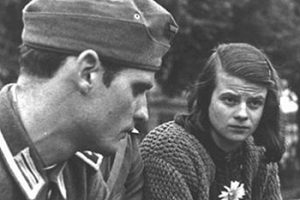
 I’ve been listening to an audiobook called the “The Germans In Normandy.” Of course, I’m not a fan of the Germans in World War II, but this book talks about the German perspective about that battle. We all think that the German soldiers went blindly into battle, faithful to their leader…or at least most of them, but the German soldiers all had doubts. They all thought Hitler was about half crazy, but they were afraid to say anything…for the most part anyway.
I’ve been listening to an audiobook called the “The Germans In Normandy.” Of course, I’m not a fan of the Germans in World War II, but this book talks about the German perspective about that battle. We all think that the German soldiers went blindly into battle, faithful to their leader…or at least most of them, but the German soldiers all had doubts. They all thought Hitler was about half crazy, but they were afraid to say anything…for the most part anyway.
As I’ve listened to the book, the Hitler Youth came into the story, and I began to wonder, not only how the Hitler Youth felt about Hitler and the Third Reich, but how many of them stayed faithful to Hitler’s ideals and how many of them turned from Hitler’s ideals. So, I did a little research.
Hitler believed that by conditioning young people in groups as the Hitler Youth, they “never be free again, not in their whole lives.” While many young individuals were profoundly influenced by these organizations, support for the Hitler Youth was not as extensive as Nazi leaders had hoped. The youth initially joined and were very excited about their participation, but as time went on, their interest declined. Many young people skipped certain meetings and activities, despite mandatory attendance requirements, resulting in inconsistent loyalty. The reasons behind their declining enthusiasm for Hitler Youth activities were not solely political or moral at times, young individuals simply grew weary of the numerous obligations or became bored. In 1939, the Social Democratic Party, which had been banned by the Nazis and operated covertly, published a report on German  youth that highlighted some of this frustration. Young people are notorious for promoting change, and that was what they thought they were doing. The restrictions placed on them by the organizers of the Hitler Youth made many of the youth want to walk away.
youth that highlighted some of this frustration. Young people are notorious for promoting change, and that was what they thought they were doing. The restrictions placed on them by the organizers of the Hitler Youth made many of the youth want to walk away.
Of those who did walk away was Hans Scholl, along with Alexander Schmorell, one of the two founding members of the White Rose resistance movement in Nazi Germany. The White Rose was a non-violent, intellectual resistance group in the Third Reich. The group was led by Hans Scholl, and his sister, Sophie, along with several other former Hitler Youth members. The students attended the University of Munich. Their objective was to raise awareness through anonymous leaflets and a graffiti campaign that called for active opposition to the Nazi regime. the anonymity of their actions, Third Reich had spies everywhere. Hans became disillusioned because he had assembled a collection of folk songs, and his young charges loved to listen to him singing, accompanying himself on his guitar. He knew not only the songs of Hitler Youth but also the folk songs of many peoples and many lands. He loved how magically a Russian or Norwegian song sounded with its dark and dragging melancholy. And he thought about what it told of the soul of those people and their homeland! Then, Hans was told the songs were not allowed. He had aways thought that people should be able to pursue the things that interested them, but now the Hitler Youth program was no longer what he thought it was, and he walked away.
Hans and Sophie Scholl, along with Christoph Probst, were prominent members of the core group. The activities of The White Rose in Munich began on June 27, 1942, and ended in the arrest of the group by the Gestapo on February 18, 1943. Those apprehended now faced death sentences or imprisonment in show trials conducted 
 by the Nazi People’s Court (Volksgerichtshof). During the trial, Sophie interrupted the judge multiple times, but her remarks went unacknowledged. The defendants were not given the opportunity to speak. They had no means to defend themselves and were declared guilty during the “trial.” They were executed by guillotine four days after their arrest, on February 22, 1943. The group, which had only been active for eight months, had never committed any violent acts. They were sentenced to death. Hitler’s regime regarded them as a greater threat due to their pamphlets and art than if they had killed people.
by the Nazi People’s Court (Volksgerichtshof). During the trial, Sophie interrupted the judge multiple times, but her remarks went unacknowledged. The defendants were not given the opportunity to speak. They had no means to defend themselves and were declared guilty during the “trial.” They were executed by guillotine four days after their arrest, on February 22, 1943. The group, which had only been active for eight months, had never committed any violent acts. They were sentenced to death. Hitler’s regime regarded them as a greater threat due to their pamphlets and art than if they had killed people.
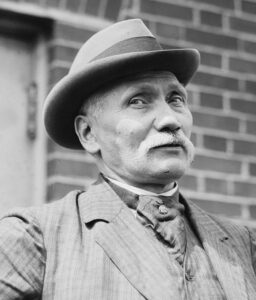
 Sometimes, you come across someone so bold and so outrageous in their actions, that you are left in complete shock. Now, I can’t say that I am the one in complete shock, but I suspect that a squad of German soldiers might have been, when on October 17, 1906, Wilhelm Voigt, a 57-year-old German shoemaker, decided to impersonate an army officer and lead an entire squad of soldiers to help him steal 4,000 marks. When calculated to American dollars and to 2023, that would be approximately $33,000. While Voigt was a shoemaker by trade, he also had a long criminal record as a thief. So, he carefully planned the robbery, knowing that the German soldiers had a long history of blind obedience.
Sometimes, you come across someone so bold and so outrageous in their actions, that you are left in complete shock. Now, I can’t say that I am the one in complete shock, but I suspect that a squad of German soldiers might have been, when on October 17, 1906, Wilhelm Voigt, a 57-year-old German shoemaker, decided to impersonate an army officer and lead an entire squad of soldiers to help him steal 4,000 marks. When calculated to American dollars and to 2023, that would be approximately $33,000. While Voigt was a shoemaker by trade, he also had a long criminal record as a thief. So, he carefully planned the robbery, knowing that the German soldiers had a long history of blind obedience.
Voigt got his hands on a captain’s uniform and hatched a plan to manipulate the German army into following his lead, thereby exploiting their blind obedience to authority and making them assist in his crazy robbery scheme. Voigt approached a troop of soldiers in Tegel, Germany. Just outside Berlin, he boldly ordered the unit to follow him 20 miles into the town of Kopenik. The group had lunch, and then Voigt put the men in position and stormed into the mayor’s office. They proceeded to arrest the mayor. He demanded to see the cash box and 
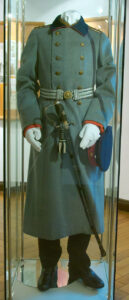 confiscated the 4,000 marks inside. The mayor was put in a car, and Voigt ordered that he be delivered to the police in Berlin. Just like that, the mayor was under arrest…by an imposter.
confiscated the 4,000 marks inside. The mayor was put in a car, and Voigt ordered that he be delivered to the police in Berlin. Just like that, the mayor was under arrest…by an imposter.
And the misfit squad of soldiers proceeded to Berlin, Voigt managed to disappear with the money. No one noticed that he had gone, and it took more than a few hours at the police station before everyone realized that it was all a hoax. As for the Kaiser…well, he thought the story was funny, but They had been humiliated by the man who was obviously impersonating a captain. They launched a massive campaign to find Voigt. They wanted revenge for the fact that they were fooled. Voigt was caught in Berlin a few days later. Voigt was found guilty and was sentenced to four years for the robbery. Somehow, the Kaiser himself pulled some strings to get him out in less than two. While he was a convicted criminal after that, the people considered him a bit of a hero for the rest of his life. He even posed for pictures for years. His little ruse, while considered a crime by the Germans, made Voigt famous.
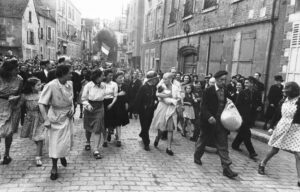 Having a baby is normally a blessed event, but it is also important to be having the baby with the right person. I know that sound like something that is between the man and the woman, and it’s nobody’s business but their own, and I would agree with you on that. However, during World War II, the Nazi regime was so hated that the nations they terrorized didn’t want anything to do with them…so much so that French women having babies with German soldiers were punished by shaving their heads bald and parading them through town. This was done so that everyone would know they betrayed their country, and so they had.
Having a baby is normally a blessed event, but it is also important to be having the baby with the right person. I know that sound like something that is between the man and the woman, and it’s nobody’s business but their own, and I would agree with you on that. However, during World War II, the Nazi regime was so hated that the nations they terrorized didn’t want anything to do with them…so much so that French women having babies with German soldiers were punished by shaving their heads bald and parading them through town. This was done so that everyone would know they betrayed their country, and so they had.
The Nazi regime was set on creating “the perfect race,” in their opinion anyway. They wanted everyone to be light skinned, blond haired, and blue eyed, and those who weren’t had to prove their genetic lines. The Nazis even went so far as to set up places that women (of the right bloodlines) were sent to have their children, conceived with German soldiers. Then, the plan was that they would give their children up for adoption by a Nazi couple who was having trouble conceiving. It was Hitler’s way of preserving the “right” bloodline. Many times, if the woman changed her mind, and wanted to keep the baby, but refused to marry the soldier, their babies were taken from the by force, even if it meant taking their lives. Some of these 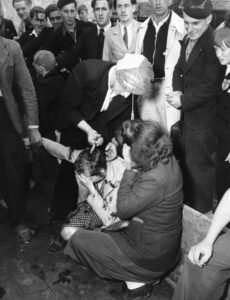 women were in it for the money and had no intention of keeping their babies. They were a simply a “Nazi Baby Machine.”
women were in it for the money and had no intention of keeping their babies. They were a simply a “Nazi Baby Machine.”
Once it was discovered that these women were doing this, they were marked as traitors. Often their own families disowned them. These women might not even be having babies with the Nazi soldiers, just having relations with them. The soldiers saw nothing wrong with hooking up with these women to ply them for information. It was an act of treason on the part of the women. They shouldn’t have allowed themselves to become involved with the Nazi soldiers, because they just had to know that was wrong. Treason is such a dark side of war. Still, there are many dark sides to war, and in most cases, it is the innocent and oppressed that suffer.
The French resistance brought out another dark side to the war, and it was rather brutal, but they felt like it was justified. Looking at it now, I think the beating part was the probably brutal, but maybe still have been justified. Basically, the French Resistance, when women were caught in a physical relationship with a Nazi, shaved their heads, beat the women who had been charged with collaborating with the enemy, and then paraded them around town as a form of punishment. The punishment was followed by harassing the women, with no repercussion for the beatings, head shavings, or the harassing. In France, a woman’s long hair is supposed to be seductive, so shaving their heads, was a way to make them look undesirable. The practice dates back to Biblical times. It was a common punishment for adultery. During the 20th century, it was reintroduced as a means to ridicule women who had physical relationships with the enemy or were prostitutes. 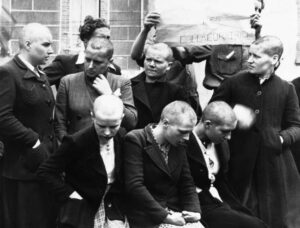 The French Resistance took a page from Bible times, and so it came to pass that during World War II, this act of humiliation was repeated on French women accused of collaborating with the German soldiers. Apart from shaving their heads, they were paraded in the streets, marked with black ink, and even stripped half-naked. At least 20,000 women have been documented to have had their heads shaved. I’m not a proponent of violence, but traitors need to be punished, and after something like that, I would think these women would think twice before getting involved with the Nazi soldiers. and any woman who hadn’t done so, would think twice before even considering such a heinous act.
The French Resistance took a page from Bible times, and so it came to pass that during World War II, this act of humiliation was repeated on French women accused of collaborating with the German soldiers. Apart from shaving their heads, they were paraded in the streets, marked with black ink, and even stripped half-naked. At least 20,000 women have been documented to have had their heads shaved. I’m not a proponent of violence, but traitors need to be punished, and after something like that, I would think these women would think twice before getting involved with the Nazi soldiers. and any woman who hadn’t done so, would think twice before even considering such a heinous act.
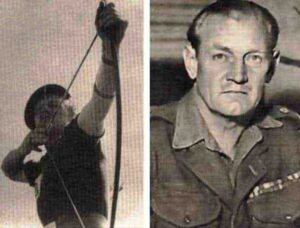
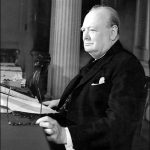 Most soldiers know that when you are trying to sneak up on your enemy, it’s probably best to leave the bagpipe playing at home. Nevertheless, John “Mad Jack” Churchill, who was one of the most colorful and unusual soldiers to fight in World War II, might find just about anything…you just never knew. The British-born “Mad Jack” Churchill had no known relation to Prime Minister Winston Spencer-Churchill, although I would not be surprised to find there was a relation. He was known for carrying a Scottish Claymore Sword into battle, and felt that any officer who didn’t have one while going into battle, was basically out of uniform. “Mad Jack”was also an avid archer and bagpipe player and brought both of these hobbies onto the battlefield.
Most soldiers know that when you are trying to sneak up on your enemy, it’s probably best to leave the bagpipe playing at home. Nevertheless, John “Mad Jack” Churchill, who was one of the most colorful and unusual soldiers to fight in World War II, might find just about anything…you just never knew. The British-born “Mad Jack” Churchill had no known relation to Prime Minister Winston Spencer-Churchill, although I would not be surprised to find there was a relation. He was known for carrying a Scottish Claymore Sword into battle, and felt that any officer who didn’t have one while going into battle, was basically out of uniform. “Mad Jack”was also an avid archer and bagpipe player and brought both of these hobbies onto the battlefield.
Churchill volunteered for Great Britain’s first-ever commando unit in 1941, and he participated in covert operations in Italy and Norway. In one Norway operation, he played his bagpipes on the landing craft as they approached the shore, then picked up his sword and attacked. In 1944, “Mad Jack” was on assignment in Yugoslavia to assist with the communist partisans under Josip “Tito” Broz, and that was when his infamous bagpipe incident happened.
During a mission to attack a German position on the Island of Brac, “Mad Jack” and his men advanced under heavy fire. In the end, he was the only one left alive. After running out of bullets, and in typical “Mad Jack” style, he picked up his bagpipe and played “Will Ye No Come Back Again?,l.” It was an 18th-century song celebrating the Jacobite Prince Charles III’s escape from being captured by the British monarchy.
Unimpressed, the Germans knocked him out with an explosion and captured him, but they spared his life…not because of his bagpipe prowess, however, but because they thought he was related to Prime Minister Winston Spencer-Churchill. They thought that having a relative of the prime minister would provide them with sone leverage. Unfortunately for them, as far as anyone knew there was no connection. “Mad Jack” was placed in a prison camp, from which he escaped captivity twice before making it home.
Churchill married Rosamund Margaret Denny, the daughter of Sir Maurice Edward Denny and granddaughter of Sir 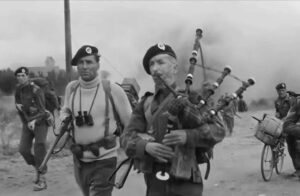
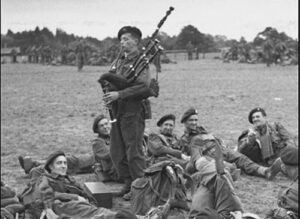 Archibald Denny, on March 8, 1941. They had two children, Malcolm John Leslie Churchill, born 1942, and Rodney Alistair Gladstone Churchill, born 1947. He also had a grandson named James Also stair Gladstone Churchill. “Mad Jack” lived a long and happy life. Nevertheless, I seriously doubt if any part of it was as crazy as the time he spent in World War I. He passed away on March 8, 1996 at 89 years old, in the county of Surrey.
Archibald Denny, on March 8, 1941. They had two children, Malcolm John Leslie Churchill, born 1942, and Rodney Alistair Gladstone Churchill, born 1947. He also had a grandson named James Also stair Gladstone Churchill. “Mad Jack” lived a long and happy life. Nevertheless, I seriously doubt if any part of it was as crazy as the time he spent in World War I. He passed away on March 8, 1996 at 89 years old, in the county of Surrey.
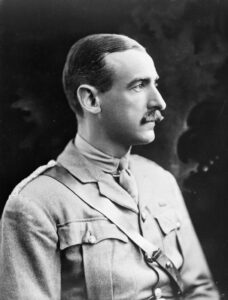 The unkillable soldier…a nickname that has deep ramifications, and a nickname no one really wants to have. It indicates that the soldier is wounded multiple times…and somehow survived. General Adrian Carton de Wiart was that soldier. He was born into an aristocratic family in Brussels, on May 5, 1880. He was the eldest son of Léon Constant Ghislain Carton de Wiart and Ernestine Wenzig. He spent his early days in Belgium and in England. When he was six years old, his parents divorced, and he moved with his father to Cairo. His mother remarried Demosthenes Gregory Cuppa later in 1886. His father was a lawyer and magistrate, as well as a director of the Cairo Electric Railways and Heliopolis Oases Company and was well connected in Egyptian governmental circles. Adrian Carton de Wiart learned to speak Arabic. He joined the British Army at the time of the Second Boer War around 1899, where he entered under the false name of “Trooper Carton,” claiming to be 25 years old, but he was actually 20. He was wounded in the stomach and groin in South Africa early in the Second Boer War and was sent home to recuperate. His father was furious when he learned his son had abandoned his studies. Nevertheless, he allowed his son to remain in the army.
The unkillable soldier…a nickname that has deep ramifications, and a nickname no one really wants to have. It indicates that the soldier is wounded multiple times…and somehow survived. General Adrian Carton de Wiart was that soldier. He was born into an aristocratic family in Brussels, on May 5, 1880. He was the eldest son of Léon Constant Ghislain Carton de Wiart and Ernestine Wenzig. He spent his early days in Belgium and in England. When he was six years old, his parents divorced, and he moved with his father to Cairo. His mother remarried Demosthenes Gregory Cuppa later in 1886. His father was a lawyer and magistrate, as well as a director of the Cairo Electric Railways and Heliopolis Oases Company and was well connected in Egyptian governmental circles. Adrian Carton de Wiart learned to speak Arabic. He joined the British Army at the time of the Second Boer War around 1899, where he entered under the false name of “Trooper Carton,” claiming to be 25 years old, but he was actually 20. He was wounded in the stomach and groin in South Africa early in the Second Boer War and was sent home to recuperate. His father was furious when he learned his son had abandoned his studies. Nevertheless, he allowed his son to remain in the army.
In 1908, he married Countess Friederike Maria Karoline Henriette Rosa Sabina Franziska Fugger von Babenhausen (1887 – 1949), eldest daughter of Karl, 5th Fürst (Prince) von Fugger-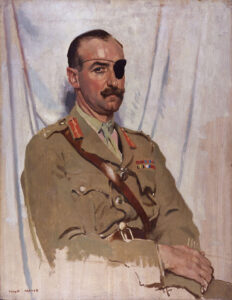 Babenhausen and Princess Eleonora zu Hohenlohe-Bartenstein und Jagstberg of Klagenfurt, Austria. They had two daughters, the elder of whom Anita (born 1909, now deceased) was the maternal grandmother of the war correspondent Anthony Loyd (born 1966). I wonder if Loyd was inspired by his grandfather’s story.
Babenhausen and Princess Eleonora zu Hohenlohe-Bartenstein und Jagstberg of Klagenfurt, Austria. They had two daughters, the elder of whom Anita (born 1909, now deceased) was the maternal grandmother of the war correspondent Anthony Loyd (born 1966). I wonder if Loyd was inspired by his grandfather’s story.
Over the course of his career, General Adrian Carton de Wiart earned the nickname “the unkillable soldier.” By 1915, he was promoted to captain and had already survived his first war…the Boer War. One night, near the French battlefield of Ypres, he and a small group of officers wandered too far into enemy territory and ran into a group of German soldiers, who fired. De Wiart was badly shot in the hand but scrambled back to his regiment. According to his memoirs, he used a “scarf he’d taken off a slain German soldier to stop the bleeding.” He was taken to a hospital where surgeons debated what to do about the gory mess of dangling fingers that had been his hand. De Wiart said, “I asked the doctor to take my fingers off; he refused, so I pulled them off myself and felt absolutely no pain in doing it.” De Wairt’s injuries were not over yet. The hand became infected and later had to be amputated. Three weeks later, De Wiart and returned to duty. He was shot several more times in his career, survived two plane crashes, and lost an eye. Over the course of four conflicts, 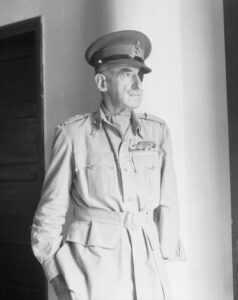 he sustained 11 grievous injuries, and simply could not be killed in war.
he sustained 11 grievous injuries, and simply could not be killed in war.
En route home via French Indochina, Carton de Wiart stopped in Rangoon as a guest of the army commander. Coming down the stairs, he slipped on coconut matting, fell down, broke several vertebrae, and knocked himself unconscious. He was admitted to Rangoon Hospital where he was treated and recovered. His wife died in 1949. Then, in 1951, at the age of 71, he married Ruth Myrtle Muriel Joan McKechnie, a divorcee known as Joan Sutherland, 23 years his junior (born in late 1903, she died January 13, 2006, at the age of 102.) They settled at Aghinagh House, Killinardrish, County Cork, Ireland. Carton de Wiart died at the age of 83 on June 5, 1963. He left no papers. He and his wife Joan are buried in Caum Churchyard just off the main Macroom road. The grave site is just outside the actual graveyard wall on the grounds of his own home.
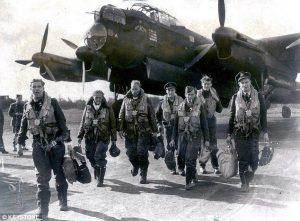 In April of 1943, during a raid on a Czechoslovakian arms factory, a British bomber crashed in Germany, going down with seven crew members on board. At the time of the crash, German soldiers recovered two of the bodies, but somehow they didn’t find or recover the bodies of the other five crewmen. It seems odd to me that they couldn’t find them, or that they somehow just chose not to bury the remaining five crewmen. Because the extensive search, following the war, produced nothing, the British Air Ministry assumed that the plane had ditched in the sea.
In April of 1943, during a raid on a Czechoslovakian arms factory, a British bomber crashed in Germany, going down with seven crew members on board. At the time of the crash, German soldiers recovered two of the bodies, but somehow they didn’t find or recover the bodies of the other five crewmen. It seems odd to me that they couldn’t find them, or that they somehow just chose not to bury the remaining five crewmen. Because the extensive search, following the war, produced nothing, the British Air Ministry assumed that the plane had ditched in the sea.
The plane, an Avro Lancaster, piloted by Alec Bone, took off from Lincolnshire, England, almost 76 years ago. Their target was a munitions plant in German-occupied Czechoslovakia. A total of 327 bombers took off that day, and 36 would never return. Bone’s plane was one of those unfortunate 36 planes. It is believed that he and his crew battled German antiaircraft fire before plunging into a field outside Laumersheim in southwestern Germany. As it searched in vain for the missing crew in the years following World War II, the British Air Ministry had no idea that German troops had already buried two of the men in Mannheim.
There was, however, one person who knew the location of the plane…Peter Menges, who was a teenager at the time he witnessed the fiery crash of the British bomber. It was a site he would ever forget, but I’m sure he assumed that the Germans had found it too, and gone to remove the bodies or any survivors. This whole  situation made me wonder why the other five men were not buried too. Upon researching this crash, I think I have discovered why. Most of us picture a plane crash with a broken plane and the bodies of the dead lying almost peacefully nearby, but most often it isn’t like that at all. When airplanes crash, they hit the ground going very fast, and the human body doesn’t handle that kind of impact very well. In fact it reacts much like an explosion, with pieces scattered all over the place. And when a plane nose dives into the ground, burying itself deep in the ground, like this one did, those body parts are often buried too.
situation made me wonder why the other five men were not buried too. Upon researching this crash, I think I have discovered why. Most of us picture a plane crash with a broken plane and the bodies of the dead lying almost peacefully nearby, but most often it isn’t like that at all. When airplanes crash, they hit the ground going very fast, and the human body doesn’t handle that kind of impact very well. In fact it reacts much like an explosion, with pieces scattered all over the place. And when a plane nose dives into the ground, burying itself deep in the ground, like this one did, those body parts are often buried too.
Menges who was 83 in 2012, when he told the tale of the fiery crash of Alec Bone’s plane. He had joined forces with Uwe Benkel, a health insurance clerk, who moonlighted as a military history researcher. Together they have helped to recover more than 100 planes. Upon learning of the exact location of the crash, a team of men used metal detectors and ground-penetrating radar to confirm the crash location near Laumersheim. Their search first unearthed the bomber’s engine and landing gear, along with hundreds of bone fragments thought to be the remains of the missing men. My guess is that because of the planes burial at the site, and the fact that most of the bodies were blown to bits at the time of the impact, the German soldiers who were at the scene to bury the bodies that day, simply could not find the other bodies.
Because no one knew where to look, the families never knew what happened for sure. They could only speculate. Now, the remains of the five British airmen have been found. Their relatives have been notified and  plans are being made to bury the men in a shared coffin at Germany’s Commonwealth War Graves Cemetery. Benkel told British news sources that area residents wondered why he was searching for former enemies who had bombed German cities. “It doesn’t make a difference if they are German or British,” he told The Telegraph. “They were young men who fought and died for their country for which they deserve a proper burial in a cemetery.” I agree. No matter which side of a battle a soldier fought on, he fought to the best of his or her abilities, and that deserves respect, and a proper burial. “They flew together and died together,” says Mr Benkel. “It is only right that they should stay together.”
plans are being made to bury the men in a shared coffin at Germany’s Commonwealth War Graves Cemetery. Benkel told British news sources that area residents wondered why he was searching for former enemies who had bombed German cities. “It doesn’t make a difference if they are German or British,” he told The Telegraph. “They were young men who fought and died for their country for which they deserve a proper burial in a cemetery.” I agree. No matter which side of a battle a soldier fought on, he fought to the best of his or her abilities, and that deserves respect, and a proper burial. “They flew together and died together,” says Mr Benkel. “It is only right that they should stay together.”

